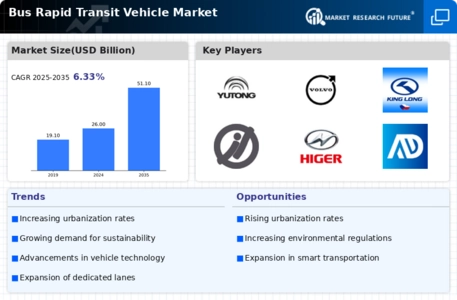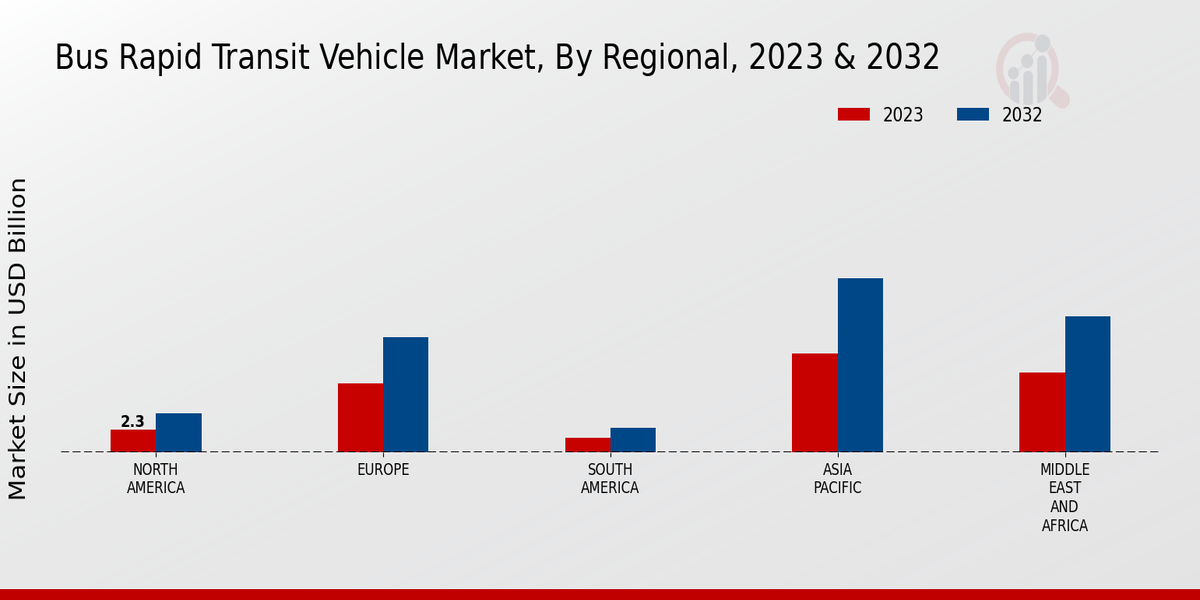Growing Urbanization
The Global Bus Rapid Transit Vehicle Market Industry is experiencing a surge due to increasing urbanization. As more people migrate to urban areas, the demand for efficient public transportation systems escalates. Cities are investing in Bus Rapid Transit (BRT) systems to alleviate traffic congestion and reduce pollution. For instance, cities like Bogotá and Jakarta have successfully implemented BRT systems, showcasing their potential to enhance urban mobility. By 2024, the market is projected to reach 26.0 USD Billion, indicating a robust growth trajectory as urban populations continue to expand.
Public Health Awareness
Public health awareness is becoming a significant driver in the Global Bus Rapid Transit Vehicle Market Industry. As urban populations become more health-conscious, there is a growing preference for public transport options that reduce reliance on personal vehicles. BRT systems, which offer efficient and reliable transportation, are increasingly viewed as a healthier alternative. This shift in public perception is likely to boost ridership and, consequently, market growth. The increasing focus on health and wellness in urban planning is expected to further enhance the attractiveness of BRT systems in the coming years.
Market Growth Projections
The Global Bus Rapid Transit Vehicle Market Industry is projected to experience substantial growth, with estimates indicating a market size of 26.0 USD Billion in 2024 and a remarkable increase to 51.1 USD Billion by 2035. This growth trajectory suggests a compound annual growth rate (CAGR) of 6.33% from 2025 to 2035. Such projections reflect the increasing recognition of BRT systems as a viable solution for urban mobility challenges. The anticipated expansion of BRT networks globally underscores the importance of investing in sustainable public transport solutions.
Technological Advancements
Technological advancements are reshaping the Global Bus Rapid Transit Vehicle Market Industry. Innovations such as real-time tracking, smart ticketing, and electric buses are enhancing the efficiency and appeal of BRT systems. These technologies not only improve the passenger experience but also optimize operational efficiency. For example, cities implementing smart traffic management systems have reported increased bus speeds and reduced wait times. As these technologies continue to evolve, they are likely to attract more users to BRT systems, contributing to the projected CAGR of 6.33% from 2025 to 2035.
Environmental Sustainability
The Global Bus Rapid Transit Vehicle Market Industry is increasingly influenced by the global emphasis on environmental sustainability. BRT systems are recognized for their ability to reduce greenhouse gas emissions and promote cleaner urban environments. By offering an alternative to private vehicle use, BRT systems can significantly lower carbon footprints. For instance, cities that have adopted BRT systems report reductions in emissions by up to 30 percent. This trend aligns with global efforts to combat climate change, making BRT systems an attractive option for cities aiming to enhance sustainability while improving public transport.
Government Initiatives and Funding
Government initiatives play a crucial role in the Global Bus Rapid Transit Vehicle Market Industry. Many governments are prioritizing investments in sustainable public transport solutions, including BRT systems, to meet environmental goals and improve urban mobility. For example, the United States has allocated significant funding for public transit projects, which includes BRT systems. This financial support is likely to stimulate market growth, with projections indicating a market size of 51.1 USD Billion by 2035. Such initiatives not only enhance public transport infrastructure but also promote economic development in urban areas.

























